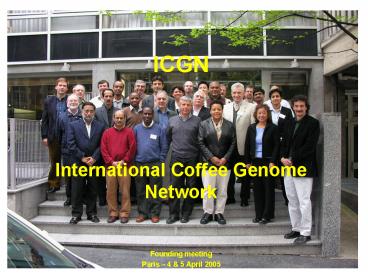ICGN International Coffee Genome Network PowerPoint PPT Presentation
1 / 18
Title: ICGN International Coffee Genome Network
1
ICGNInternational Coffee Genome Network
- Founding meeting
- Paris 4 5 April 2005
2
Mission
- ICGN is committed to advancing genomic research
through international partnerships for
sustainable coffee - production
3
ICGN Goals
- Facilitate information and resource sharing
within the scientific community - Provide to breeders molecular tools and relevant
knowledge - Access and share knowledge on genetics and the
molecular basis of important traits - Use and conserve genetic resources
- Ensure benefits to growers and consumers
- Ensure the sustainability of the coffee
production chain (social, economical,
environmental)
4
Network membership criteria
- Research scientist on coffee and / or genomics
- Representatives of
- Companies
- Networks (RECA, PROMECAFE, CORNET,)
- Institutes
5
Tasks of 1st Steering Committee
- To propose medium and long term strategies
- To adopt and coordinate common set of specific
activities - To raise funds and to support research proposals
- To approve new memberships
- To promote the training of scientists
- To advise on IPR and legal issues
- The first steering committee will prepare the
terms of reference
6
1st Steering Committee
- Composition
- Working group representative 6 (3 P 3C)
- Coordinator 1
- IPGRI 1
- Private company 1
- Grower representation 1
- Consumer representation 1
- Total 11
- Mandate duration Until next ASIC meeting
(Sept. 2006) - P producer country, C consumer country
7
Secretariat
- Assists the steering committee
- Facilitates communication between network members
- Coordinates information exchange
- (mailing list, web pages, workshops, meetings)
- The offer of IPGRIs representative to host the
secretariat has been positively received but
remains to be endorsed.
8
Network coordinator
- The mandate of the network coordinator will be
defined by the 1st steering committee - André Charrier was confirmed as coordinator until
the next ASIC meeting
9
Working groups
- WG1 - Markers and genetic diversity
- WG2 Markers and genetic mapping
- WG3 BAC libraries, physical maps
- WG4 ESTs and transcriptional profiling
- WG5 Tools for functional analysis
- WG6 - Bio-informatics
- BACBacterial Artificial Chromosome,
ESTExpressed Sequence Tag
10
WG1- Markers and genetic diversityCoordinators
L. Johnson (CATIE), C. Agwanda (CORNET)
- Objectives
- Define a common set of markers
- Identify a common set of germplasm for ring test
- Develop allele bins
- Set up a central database
11
WG2 Markers and genetic mappingCoordinators
R. Ming (Univ. Hawaï), T. Leroy (CIRAD)
- Objectives
- Identify and/or develop segregating populations
(diversity maximization, population size,
possibility of using micro-propagation for
distribution) - Select a common set of markers (accessible on the
web), adopt common markers and chromosome
nomenclature - Develop two common references maps. Integrate all
genetic maps/density genetic map - ESTs, SNP and relationship with physical mapping
- SNP (Single Nucleotide Polymorphism)
12
WG3 - BAC Libraries physical mapsCoordinators
Ph. Lashermes (IRD), J. Carlos Herrera
(Cenicafé)
- Objectives
- Access to the available Canephora and Arabica -
BAC libraries - Define a common reference BAC library
corresponding to one of the parent involved in
the reference segregating population high
density map (see above) - Initiate the construction of a physical map based
on BAC fingerprinting - Sequence BAC ends
- Integrate the physical map with the reference
genetic maps - Long-term goals
- Construct BAC libraries with relative species
- Sequence the complete coffee genome
- Sequence homologous regions in different wild
species
13
WG4 - EST transcriptional profilingCoordinators
A. Andrade (EMBRAPA), G. Graziosi (univ.
Trieste)
- Objectives
- Identify available ESTs
- Pool the data and develop a framework for
analyzing EST sequence information - Reduce duplication and increase EST coverage
- Develop an EST UNIGENE set
- Develop microarrays using UNIGENE for expression
studies - Provide EST resource for genetic and physical
mapping - Initiate comparative genomics (within and outside
the genus e.g. SOL) - Identify key genes involved in different traits
14
WG5 Tools for functional analysisCoordinators
H. Etienne (CIRAD), HL. Sreenath (India)
- Objectives
- Develop tools for gene function validation
- Genetic transformation
- Mutagenesis
- Share the technology between ICGN members
15
WG6 - Bio-informaticsCoordinators to be
identified. Rajkumar (Unido), B. Courtois
(Cirad), Da Silva (Embrapa), L. Mueller (Cornell)
- Objectives
- Establish bio-informatics needs
- Encourage submissions to public repositories
- Identify informatics solution for global coffee
data system - Initiate a web-based community forum
- Integrate databases (including morpho-agronomical
traits)
Institutes considered for database management
Cornell Univ. (USA), Cirad (France), Embrapa
(Brazil), Trieste Univ. (Italy)
16
WG coordinators
From producer country From consumer country
17
Upcoming announcements
- Internal communication
- Diffusion of documents
- External communication
- Announce the launching of ICGN on Websites
(ASIC, ICGN) - Inform international organizations ICO and
others - By the secretariat supervised by the Network
coordinator
18
Next ICGN meetings
- Trieste meeting (to be confirmed by September
2005) - Objective to follow up on WG activities
- Date and place Early 2006 in Trieste (Italy)
- Organizer G. Grasiozi and UNIDO (ICS)
- XXI ASIC meeting
- Objective to follow up on WG activities and
network development - Date and place September 2006 in Montpellier
(France)

